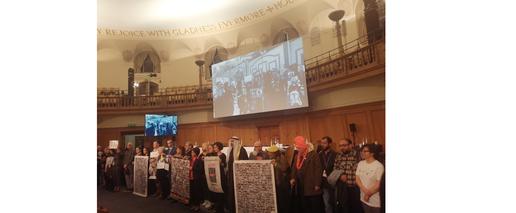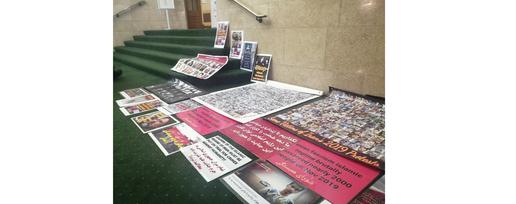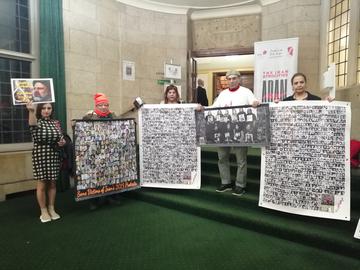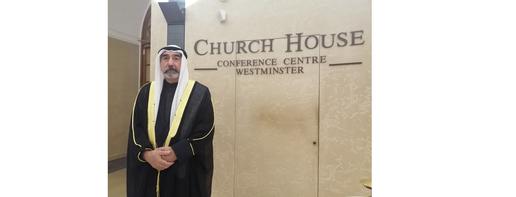The Aban Tribunal has adjourned in Church House, London after five days of witness testimonies on crimes committed by the Iranian state in November 2019. The panel has seen more than 100 written submissions of murder, torture and human rights abuses committed in 28 of the country’s 31 provinces.
Millions of Iranians inside the country watched live broadcasts of the independent people’s tribunal, which aims to bring a modicum of accountability for the atrocities. The panel heard from parents grieving for their children, survivors of medieval torture and sexual abuse, people with life-changing injuries from being shot with live ammunition, and members of the security forces who confirmed under oath that a multitude of crimes had taken place, both that bloody month and afterward.
A total of 133 officials are accused: Ali Khamenei and the Supreme National Security Council, but also governors, IRGC commanders, police chiefs and others who allowed forces under their command to wantonly kill and brutalize civilians. None of the 133 made any representation to the tribunal, despite repeated invitations to do so.
In his closing remarks, panel chair Wayne Jordash QC said: “The evidence currently raises a serious case against the Islamic Republic of Iran. That case suggests they are responsible for a variety of crimes against humanity.”
Since the first hearing on Wednesday, hundreds more people have called the Aban Tribunal organizers asking to come forward as witnesses. In response, Jordash confirmed on Sunday that he had agreed to keep the record open to new submissions until the final judgment is issued in early 2022. Due to the “scope” of the new evidence being offered, he said, the tribunal may also hold further hearings.
“You Are the Voice of the Voiceless”
Summing up, co-counsel Hamid Sabi said: “The record is far from complete. While the counsel has interviewed more than 200 witnesses, this is the tip of the iceberg.” But he said the impact the tribunal was already having was indisputable. He quoted a testimony by activist Azadeh Pourzand, whose father Siamak Pourzand, a journalist and prisoner of conscience, took his own life under house arrest in Iran in 2011.
“After many years of struggle against myself not to be a victim, for fear of appearing weak and unreasonable, it was the first time that being a victim felt powerful, felt strong, felt capable of bringing justice in its barest and least abstract manner. I looked at the judges, and I felt safe.”
Many other Iranians, Sabi said, were now feeling the same. “That’s not limited to those who suffered the atrocities of Aban two years ago. This tribunal has been a wake-up call for the authorities in Iran that believe they can get away with all the crimes they have committed over the last four decades against the Iranian nation. They have no answer, and never had an answer, for the families of those who fell victim to the guns.”
Thanking the witnesses, he said: “There’s no better way to say it: you are the voice of the voiceless.” Finally he paid tribute to Mohammad Hashemdar: a single, newly-identified victim of the guns, for whom no-one had spoken inside or outside of Iran until Witness 179 raised his name on Saturday. “He saved an employee of the bank while the fire was going on, and minutes later, he was shot dead by police officers. His family lost a breadwinner. No-one has mentioned his name. You are the ones who can do that.”
What Happens Now?
Based on what has been heard so far, co-organizers of the Aban Tribunal hope to press for countries to impose Magnitsky sanctions – targeted sanctions against individuals, including asset freezes and travel bans – against the 133 identified perpetrators.
A report on potential crimes against humanity committed in November 2019, compiled by Robert Heinsch, a professor of international law at Leiden University, and colleagues and presented to the Aban Tribunal on Saturday, is being submitted to the International Criminal Court to begin an investigation under Article 7 of the Rome Statute.
The findings of the Aban Tribunal have no legal weight by themselves. But it can be used to support any future criminal or judicial proceedings against the perpetrators. The tribunal’s precursor, the Iran Tribunal, which focused on Iran’s 1988 prison massacre, is currently supporting the prosecution in Sweden of ex-prison official Hamid Nouri for war crimes and murder.
A Step Closer to Justice
At the close of proceedings on Sunday, co-organizers, activists and supporters gathered at the foot of the podium in the Assembly Hall. Behind them, on the screen from which 33 witnesses had spoken out over the past five days, a series of black-and-white photographs showing victims of regime atrocities in Iran were displayed one by one. Among them was a picture of Nahid Shirpiseh: the mother of 27-year-old Pouya Bakhtiari, who was shot dead on November 16, 2019.
Shadi Sadr, director of Justice for Iran, said the panel had created a safe space for victims dismissed as “rioters” and “terrorists” in their own country “to stand tall and with pride, to voice the truth to the world. For the first time in an international forum, the real plaintiffs have accused the real perpetrators.”
Mahmood Amiry-Moghaddam, director of Iran Human Rights, said: “By amplifying the voices of victims and their families, the tribunal has given hope to millions of Iranians that their voices have been heard globally. In the short term, the public will realise they are not powerless, and the authorities will show restraint next time protesters take to the street. In the long term, the tribunal will bring victims a step closer to justice and accountability.”
Those who attended also said they felt vindicated by what they had seen. “All dictators have the same idea,” activist Hassan Ahmadi told IranWire. “To implement force over people, or control them. I liked that they condemned the regime today, that there was enough evidence to show that.”
Yousef Azizi Benitorof, an Iranian Arab writer from Khuzestan (called Ahwaz by Arabs) and former political prisoner who now lives in exile in London, said it was important for him to come because of the “massacre” of Arabs in November 2019. For them, he said, the protests had had an ethnic dimension. “They killed us in the Jarrahi marshes. When demonstrators fled, they pursued them there.” Tanks and machine guns had been used on crowds in in Bandar-e Mahshahr (Ma'shoor), Benitorof said, and soldiers called the protesters “Sunnis”, “Wahhabis” and “terrorists”.
“Even though it’s not official,” Benitorof added, “the tribunal has had an effect on national opinion in Iran. Even on the borders: people have contacted me from Hor al-Azim, and from all parts of Iran.” He said he hoped the international community was also watching.
One woman, who asked not to be named, observed the final remarks alone from the upper gallery of the Assembly Hall. She told IranWire that six of her family members and in-laws were murdered by the regime in the 1980s. “We want justice for all,” she said. “We want this government to be exposed.”
Related coverage:
Aban Tribunal: Witnesses Say Regime Agents, Not Protesters, Burned the Banks
Aban Tribunal: IRGC Construction Staff Armed and Made to Suppress Protests
Deputy Speaker: 'I Shot People. Who Wants to Put Us on Trial?'
Aban Tribunal: Victims of Gunfire and Torture Denounce 'Criminals'
Aban Tribunal: Troops Stalked Hospitals, Cemeteries After November 2019 Killings
Aban Tribunal: Security Forces' Hired Thugs Executed After Missions
A Tale of Two Irans, Two Londons
Aban Tribunal: Shock Day 2 Testimonies Reveal Scope of State Violence
Aban Tribunal: Police Major 'Prosecuted for Refusing to Shoot'
Aban Tribunal: Detainees 'Drugged and Made to Simulate Their Funerals'
Aban Tribunal: Iranians Testify on November 2019 Atrocities in London
The Names of All 133 Officials Accused of November 2019 Crimes
visit the accountability section
In this section of Iran Wire, you can contact the officials and launch your campaign for various problems






























comments